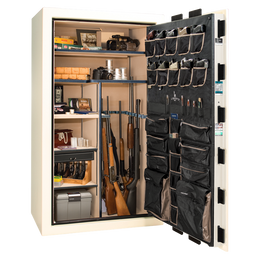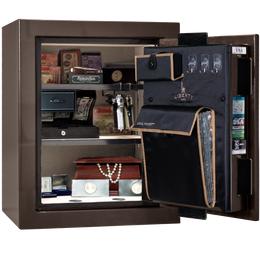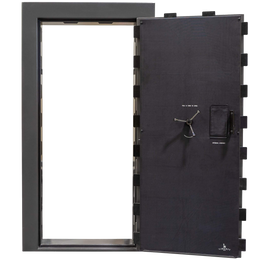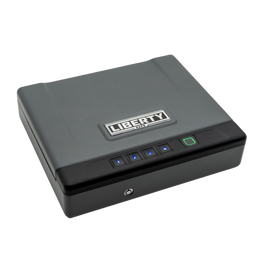Frequently Asked Questions
Are Electronic Locks EMP Resistant?
The SecuRam Electronic Locks on Liberty Safes are EMP Resistant!
The S&G Low Profile and D-Drive Electronic Locks on Liberty Safes are also EMP Resistant. The NL and S&G biometric electronic locks are not EMP resistant.
SecuRam Electronic Lock Third Party EMP Testing
How does the key-lock work?
It is used to lock the dial from turning. You can lock the dial combination scrambled or open. Simply set the dial to "0", insert the key and turn half a turn counterclockwise. This will lock the safe. To unlock, turnkey half a turn clockwise, remove the key and either redial combo or turn dial back to opening position.
Can I change the safe's combination?
If the gun safe is equipped with an electronic lock refer to the "Changing Your Combination" instructions in this manual. (The SecuRam and S&G operating instructions for biometric locks are included in your packet as well). If the safe is equipped with a mechanical dial lock you must contact a locksmith or your local dealer to have the combination reset.
Operating Gun Safe Locks
Why is the handle pointing in a different direction than it used to be?
The handle has a built in clutch mechanism. When the handle is forced it will slip left or right. To reset it simply force it back to it's original position when locked.
What is routine maintenance and who is qualified to do it?
Routine maintenance is to keep your safes lock is in good working condition and may prevent costly lockouts. Most locksmiths can perform the work. Make sure that they are familiar with SecuRam and Sargent & Greenleaf® group II locks.
What if I lose my keys or combination?
A Duplicate Key/Combination request form must be filled out and faxed along with a copy of the sales receipt to: (801) 465-5940.
Print off the form below.
Can an electronic lock be installed on the safe?
Most mechanical locks can be swapped out with an electronic lock. To verify if your safe can have an electronic lock installed call technical support at 800-247-5625, supply your safes serial number and a member of our support team will be able to verify if your safe can have an electronic lock installed.
Read this for the Pros and Cons of Mechanical Safe Locks and Electronic Safe Locks.
Troubleshooting Guide
Dehumidifier Will Not Plug into the New Outlet Kit
The dehumidifiers have thicker prongs and it catches on the contacts of the new outlet kit. Two simple solutions usually work. 1. Try to plug in another 3-prong plug that has thinner prongs. If it works, that usually spreads the contacts out and the dehumidifier will work. 2. It that doesn't work, file an angle on the tips of the dehumidifier prongs so that it creates a wedge. Plug it in and if it works problem solved. If that doesn't work, contact Liberty's customer service department at 800-247-5625.
Key Will Not Turn
Verify that the combination dial is set at zero before attempting to turn the key. Make sure key is fully inserted before attempting to turn key.
Combination Opens the Safe Intermittently
Check lock-bolt pressure. Some free play should exist in the handle, left to right. Try dialing the combination again. Bolt pressure may be due to out of place interior shelves or improper personal storage (i.e. gun barrels, items too big for shelves).
Combination Will Not Open the Safe
Check lock-bolt pressure. Some free play should exist in the handle, left to right. Redial the complete combination stopping at "0" (before reaching "87"). Hold dial on "0" while rattling the handle left and right. Then turn the dial right until it stops at about "87". PLEASE NOTE: If your lock still does not open, it is possible that one or more of your numbers may be off slightly from those shown in this manual. The combination number may have shifted slightly during shipping. Try dialing 1 up or 1 down from each number in the combination. If it opens with a new number, update your combination in this book and report it to Liberty Safe (800) 247-5625, Press 0.
Combination Dial is Tight or Will Not Turn
Verify that the key-lock is unlocked (jagged edge of key will be facing up) before attempting to turn dial. Check lock-bolt pressure. Some free play should exist in the handle, left to right. Bolt pressure may be due to out of place interior shelves or improper personal storage. Make sure the door is completely closed and the locking bolts are in the fully extended position. Normally dial tightness varies from safe to safe. Tightness of dial may increase or decrease as dial is being turned.
Combination Works but Handle Will Not Turn
Verify that the dial has completely stopped (turning to the right) on or about "87" before turning the handle. Corner protectors (packaging material) may cause undue pressure on the locking bolts. To alleviate the pressure push in on the door while pulling out and turning the handle to open the safe. If the handle turns partially the bolts may be jammed or caught up. Try rotating the handle back and forth (left to right) until the bolts free up. Use a cotton cloth and light oil to rub each chrome locking bolt on the open and hinge side of the door.
Combination Works and Handle Turns but Safe Will Not Open
Verify that the handle has been completely rotated in the open position before opening the door. Check the Allen set screw located on the front (center of handle under sticker) or side of the handle hub for tightness. Some safes are installed with a unique handle clutch mechanism. Improper personal storage or over tightening the door adjusting mechanism may cause the clutch to temporarily engage. Try pushing in on the door while pulling out and turning the handle. You may have to repeat this step several times until door is open.
Door Rattles When Shut
Adjust Door. Also, verify that the handle has rotated completely and that the chrome locking bolts are fully extended.
Door Will Not Shut
Verify that the lock is unlocked and the chrome locking bolts are fully retracted. Make sure the interior shelves are pushed back as far as possible, and that the floorboard is pressed down to the bottom of the safe floor. The handle should travel the same distance with the door closed as it does with the door open.
Door Shuts but Will Not Lock
Verify that the door is shut completely, the handle rotated completely and chrome locking bolts are extended to their locked position. Then rotate the dial to lock the safe. Verify that interior shelves are pushed back as far as possible, and that the floorboard is pressed down to the bottom of the safe floor. (For electronic locks see the next section.)
Locking Bars Do Not Retract to Close Door
Verify that the dial is unlocked and has stopped on or about "87" before turning the handle. On models with electronic locks make sure the electronic lock is unlocked. Bolts may become dry and need oil. Use a cotton cloth and light oil to rub each bolt entirely, front & back of door.
Electronic Lock Will Not Open
- The locking mechanism of a safe can, under certain conditions, place pressure on the side of the lock's bolt. This is often caused by something inside the safe pressing against the door or by something caught between the safe door and its frame. When this occurs, the lock will not operate properly. To relieve side pressure on the lock bolt, move the safe's handle to the fully locked position, (for direct-drive locks make sure the keypad is turned counterclockwise to stop), then re- enter a working code. The lock should open.
- If the lock "chirps" when keys are pressed, but it will not open, the batteries may be drained to the point that they will not operate enough to open the lock. Follow the battery replacement procedure in this manual.
Electronic Lock Will Not Lock
- If the lock "chirps" when keys are pressed, but it will not open, the batteries may be drained to the point that they will not operate enough to lock the lock. Follow the battery replacement procedure in this manual.
- For single battery keypads, the battery may not be making good contact with the keypad terminals. To improve battery contact, remove the battery tray and bend down the thin metal contact tabs located inside the battery tray compartment at the top. Then replace the battery tray and enter your code a few times until lock begins to lock.
- For D-Drive locks try the following:
- Open the door all of the way and extend the bolts.
- Slide the keypad housing away from the door (similar to changing the batteries).
- Locate the spindle plate that rests against the safe door, directly behind the keypad.
- There are two ears (tips) on the plate that are positioned between 12 and 2 o'clock. Verify the door is open all of the way and the bolts are extended to their locked position. Slide the two ears counterclockwise to the 12 o'clock position. The lock should click and chirp once. Try the handle, it should be locked.
WARRANTY CLAIMS
Please read carefully the safe warranty that accompanied your safe. If you encounter a problem that falls under the warranty coverage, simply call one of our Customer Service Representative's at (800) 247-5625, press 4. You will be required to provide the serial number and proof of ownership if you have not sent in your warranty card.
WARRANTY REPAIRS
Repairs to your safe covered under your warranty should not be performed without the pre-authorization of a Liberty Safe customer service representative. If there are any issues regarding your safe please contact a Liberty Safe Customer Service Representative (CSR) at (800) 247-5625. Solutions to frequently asked questions and issues can also be found in Trouble Shooting Guide in this booklet or on line at www.libertysafe.com. The cost of any repairs performed without pre-authorization will be the sole responsibility of the owner.
WATER AND FIRE DAMAGE
Your safe is not waterproof. Should your safe be exposed to fire or water, the fire insulation of your safe will be compromised. In this event, make sure to have your safe opened as soon as possible. If your safe included firearms, remove them and have them cleaned and lubricated as soon as possible. Do not continue to store items in a safe that has been compromised by water or fire. You should purchase a replacement model in either case.
INSURANCE COVERAGE
Liberty safe does not insure the contents of your safe. A homeowner's policy or other insurance coverage should be purchased in an amount sufficient to cover the contents. Most homeowner's policies require the purchase of riders or endorsements on items such as guns, jewelry coins and other valuable collectibles. Should damage occur to your valuables, a claim should be made with your homeowners insurance. Check with your local insurance company for possible discounts that may be available with your purchase.
Fill In the Form If You Need Assistance With Your Liberty Home or Gun Safe
If you have a general inquiry or are needing an update on your order please email us at customerservice@libertysafe.com.
*Made in the U.S.A. from U.S. and Global Parts.





